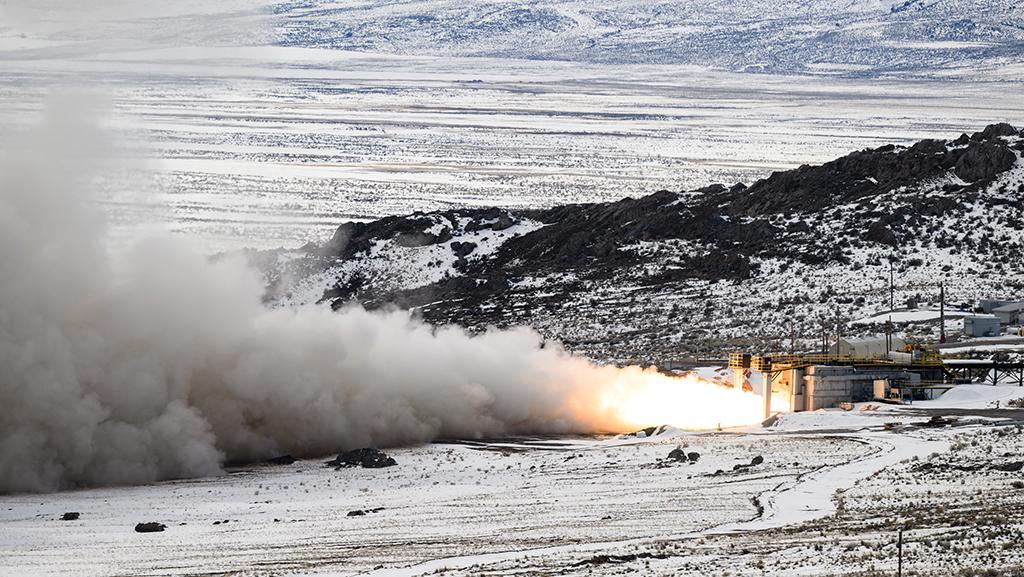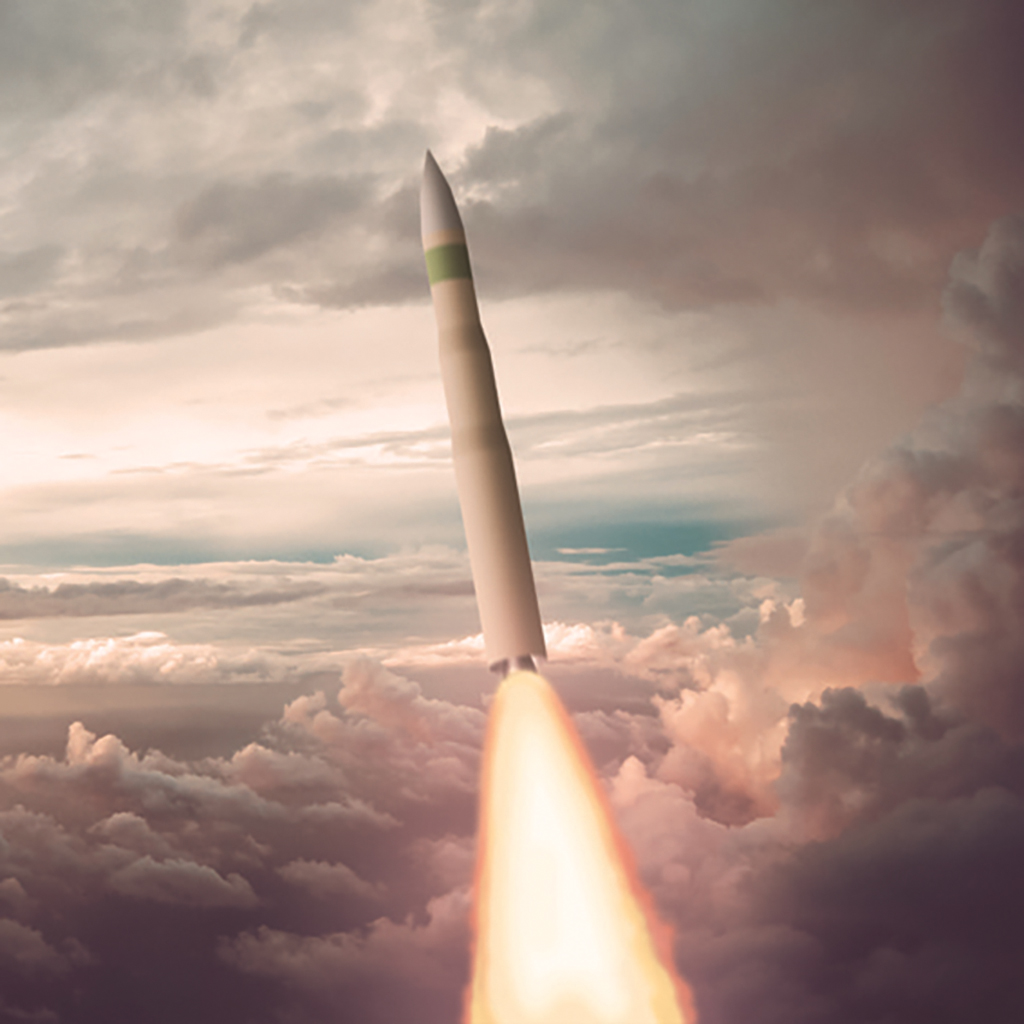
Northrop Grumman and the Air Force test-fired the Sentinel’s solid rocket motor in March ahead of a planned first flight this year.
The U.S. Air Force’s largest modernization program to overhaul the entire ground-based leg of the nation’s nuclear triad is facing schedule uncertainty in its early stages, before the hardest part of the program begins.
The LGM-35A Sentinel, previously known as the Ground-Based Strategic Deterrent, will replace the current Cold War-era Minuteman III ICBMs and modernize the broad swath of hundreds of ground alert stations across the Great Plains. The missile is still set to make its first flight test this year, officials say, although Northrop Grumman, Air Force and independent assessments all question the massive program’s ability to meet its schedule targets.
- The GAO blasts the accuracy of U.S. Air Force Sentinel schedule
- The service faces a land-use struggle in updating silos
- Congress and the White House disagree on new sub-launched missile
“We’re in the process of working with the Air Force on looking to optimize the schedule to see what we can pull left, what obviously is shifting right, and how we can maintain the initial operating capability date, which is the primary focus of the government so that we can replace those missiles in the silos as anticipated later in the decade,” Northrop Grumman CEO Kathy Warden told investors in July.
Air Force Secretary Frank Kendall, who has had to recuse himself from decisions relating to the program because of past work with Northrop, has also raised concerns to lawmakers. In May, he told the House Armed Services Committee the program was holding to its schedule for initial operational capability in 2029, but noted: “My sense of this is . . . it’s going to be a challenge to make that.”
The Air Force is spending heavily on the Sentinel, with $38.6 billion projected over the next five years—a higher price than what is planned to be spent on other major programs such as Northrop’s B-21 Raider. This does include related spending on other components, such as the Mk21A reentry vehicle, ICBM Fuze Modernization Program and other spending to keep Minuteman IIIs healthy ahead of the Sentinel’s fielding. The Government Accountability Office (GAO) in a June report pegged total Sentinel spending for 659 missiles at $52.4 billion for procurement and $25.2 billion for development.
With the first flight test expected this calendar year, critical design review is planned for mid-2024. However, the assessment raises further questions about whether the Air Force and Northrop are accurately projecting the Sentinel’s path. Staffing shortfalls and clearance processing delays as well as supply chain disruptions are affecting plans. Some testing stumbles have occurred, too, such as the July 2022 attempted flight test of the Mk21A reentry vehicle that failed after the Minotaur II+ rocket exploded shortly after launch.
“According to the program office, Sentinel’s master schedule contains many deficiencies and cannot be used to effectively manage the execution of the program,” the GAO says. “The prime contractor and the program are conducting a high-level review and discussing potential changes to the schedule.”
Northrop appears to be feeling pressure about the Sentinel’s performance in these early stages. Warden has told investors the program is a large part of the company’s overall $79 billion backlog. Some of this is attributed to inflation, but the contract nature of the program should provide some help, she says.
“Programs that are a significant amount of that backlog are programs like Sentinel, a sizable program that was awarded in 2020 or 2021 and is going to carry forward for several more years as part of that [engineering, manufacturing and development] program in backlog,” she says. “And there are several others, but none that rise to that level. But I will remind you that Sentinel program is a cost-plus program.”
Lawmakers also have taken notice. The House Armed Services Committee’s draft 2024 defense policy bill requires the Air Force to submit a new integrated master schedule for the Sentinel along with quarterly briefings on the program’s progress through 2029.

For now, inside the building and across the military commands, the schedule remains in place, and the acquisition authority, Bill LaPlante, under secretary of defense for acquisition and sustainment, is not reporting any changes.
Air Force Gen. Anthony Cotton, commander of U.S. Strategic Command, said Aug. 16 that he is optimistic the Sentinel program will progress because the Minuteman III system is becoming more difficult to sustain from an operational perspective.
“I’m a missileer by trade,” he says. “As I look at where we are with Sentinel, I’m optimistic that we’re going to be able to do well. The Minuteman III system, to be frank, is still a valid, effective weapon system. . . . The problem with any legacy system is the fact that the sustainment is so burdensome on the young airmen who have to maintain those weapons systems, right? And when it comes to that, it’s being able to be more efficient on how you sustain those weapons systems moving forward. So that’s why I’m looking forward to the transition to more modernized, open-architecture systems.”
In many ways, developing the missile is a simpler task for the overall Sentinel effort. To put the missiles into silos with updated alert facilities to handle them, the Air Force will have to modernize 450 silos and more than 600 facilities spread out over 31,900 mi.2 across Colorado, Montana, North Dakota and Wyoming. The military construction slice of Sentinel program spending is $19.4 billion over the next five years, and work will have to be done quickly, says Brig. Gen. Ty Neuman, the director of concepts and strategy for Air Force Futures, who previously served as the National Security Council’s director of strategic capabilities.
“I have to do, on average, one silo per week for nine straight years,” Neuman told a Washington-area audience in February.
The project is also facing encroachment issues. The service put forward a legislative proposal to protect facilities from one particular problem: wind turbines being built across the region to provide more wind power, which can create “extreme flight hazards” for Air Force helicopters that need to reach the alert facilities, the service says.
Wind turbines are encroaching on 46 ICBM facilities within 2 nm. The Air Force’s proposal would prevent further encroachment on all of its 495 facilities. The service says its proposal is to create presumptive Defense Department national security objections for prospective wind turbine and antennae projects within 2 nm of ICBM launch and alert facilities. The current Defense Department processes were established when wind turbines were expected to reach 300 ft. in height, though some turbines now are more than 700 ft. tall.
A modified version of the proposal was included in the Senate’s draft policy bill but did not make it into the floor version of the House’s measure.
“This provision is critical to flight safety and the national security of the land-based leg of our nuclear triad,” the Air Force argues.
Meanwhile, before the Sentinel is operational, the Air Force plans to spend about $8 billion over the next five years to improve the Minuteman III to address aging and obsolescence issues.
The Sentinel program is just one of multiple nuclear modernization efforts underway across the military. For the Air Force, another weapon-focused effort is the ongoing and secretive AGM-181A Long-Range Stand-Off (LRSO) weapon. In July 2021, RTX, then Raytheon, received a $2 billion contract to develop the LRSO to replace the service’s aging Boeing AGM-86 Air-Launched Cruise Missile.
The Air Force plans to spend $5.85 billion over the next five years to develop the LRSO. The program has achieved Milestone B and has entered engineering and manufacturing development, with a Milestone C production decision expected in the third quarter of fiscal 2027.
The LRSO is intended to be carried by the modernized Boeing B-52J and the upcoming B-21. As with the Sentinel, Northrop was expected to conduct the B-21’s first flight by year-end.
The U.S. Navy also is modernizing its nuclear weapons, although its effort has been met with controversy and uncertainty. The Submarine-Launched Cruise Missile-Nuclear (SLCM-N) was created in the Trump administration’s 2018 Nuclear Policy Review as an option for a shorter-range, nonballistic tactical nuclear weapon.
However, the Biden administration called for its cancellation in its 2022 Nuclear Posture Review, saying it was unnecessary and would take funding away from more important modernization efforts.
But lawmakers are pressing to continue the SLCM-N’s development despite the White House’s position. Asked about the SLCM-N in August, Cotton said it could fill a gap, and he would “love to be able to see what we have in low-yield, nonballistic, low-generable assets moving forward.”
The U.S. Strategic Command is reviewing the issue ahead of a possible recommendation, Cotton says.
“[Having] more options is better than fewer options,” he says. “If I’m presenting to the president of the United States, I’d love to be able to have more options.”

